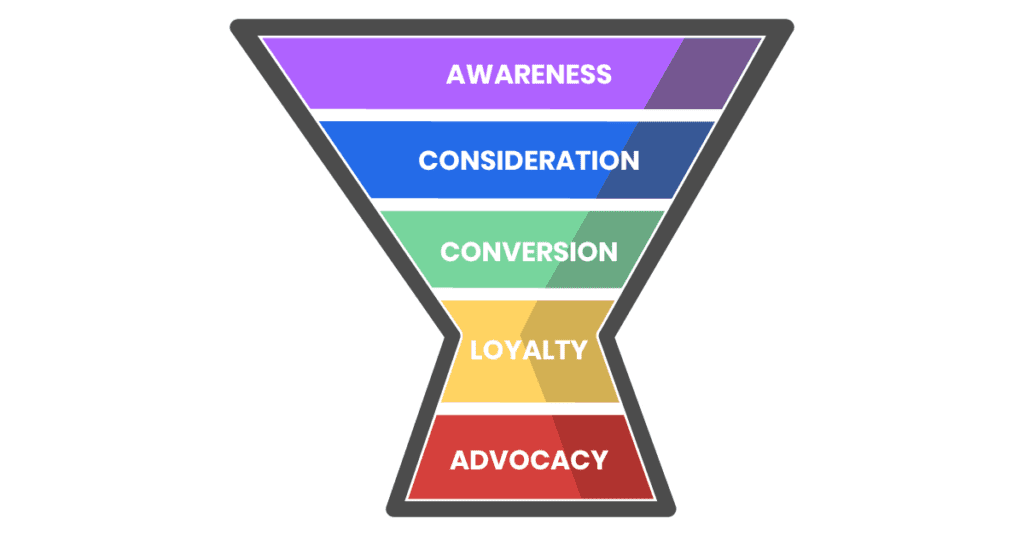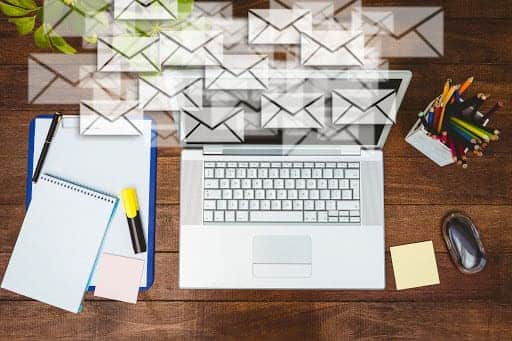You know you have a great product! All the pre-roll studies conducted with participants have borne exceptional results. But, even with such insight, you cannot expect hordes of conversions the minute you launch it.
Instead, you must take a strategic approach where you first:
- Educate prospects on the problems they face
- Place a brand offering, which is your product or service
- Highlight what they would miss out on if they don’t buy what you’re marketing.
And, then rake in the moolah, which would be well-deserved! Now, you achieve all of this by sending emails on a timeline to take a prospect from one step to the next within their buying journey. There would be a sequence for each lead, starting with a welcome email to a brand awareness email to a nurture email to a subscription email.
Your email sequence decides how a prospect moves through a sales pitch, and this is what an email marketing funnel entails.
A Lean, Clean Definition of an Email Marketing Funnel
This metaphorical funnel lists out how a prospect goes from a lead to a loyal customer through the power of email marketing. The journey from lead acquisition to conversion is represented as a five-step funnel. Here is a visual representation of an email marketing funnel.

Let’s look at each stage of the funnel more closely:
1. Awareness
At this stage, brands work on awareness strategies by sending out product-related content to the masses. They try to showcase the true value of their offering to garner more email list subscribers. Once people subscribe to their email list, they become acquired leads aware of the brand’s presence and possibly open to the solutions they offer.
2. Consideration
Not all leads will open your emails, and many will eventually unsubscribe. But a significant chunk will express interest by opening your communication, clicking through it, and requesting callbacks. These leads are somewhat interested in what you have to sell. With them, you must reinforce the problems your product solves.
3. Conversion
If the prospect has passed through the above two stages and your sales email contains the right CTAs, you will experience conversion. A lead becomes a first-time customer here, but this is not where the funnel stops. It gets narrower as the following two stages are both critical and difficult to achieve.
4. Loyalty
Businesses are not built on one-time buyers; they require repeat purchases that come from loyal customers. After the initial sales, keep your customers interested by sharing relevant content, educating them on novel solutions you offer, and pitching personalized time-sensitive offers. If you nurture your buyers the right way, you will champion customer loyalty.
5. Advocacy
If you brought a subscriber here, expect referral marketing, which is essentially word-of-mouth. Getting a customer here is hard but exceptionally valuable. Work on retention strategies for these buyers and also gather feedback about your product from them. That is the only way to bring other prospects and customers into the narrow side of the email marketing funnel.
Looking for a Blueprint to Create Your Email Marketing Funnel? Here it is!
The funnel above lists the values that should govern your email sequencing. Here’s the blueprint for putting those values into action.
Step 1. Generate and Nurture Leads
For sending marketing emails, you need an email list. You can procure one through:
- A third-party email list vendor
- User-friendly landing pages that offer free trials embedded with opt-in forms
- SEO optimized blog site(s) with pop-ups
- Sharing valuable gated content like case studies and white papers on blog sites or landing pages in exchange for email ids
- Increasing followers on social media pages for acquiring lead email ids.
Remember, all your lead generation sources must carry valuable content. Don’t move to directly selling your product at this stage. Show your potential prospects the value of subscribing to your email communication and newsletters. Once you’ve grabbed their attention, segment the lead emails on age, demography, likes, and dislikes to send personalized content.
For example, after acquisition and learning about a particular lead segment’s preferences, send relevant case studies, articles, webinar event invites, etc., to keep them hooked.
Sharing generic content at the lead nurturing stage is a strict no-no, as 71% of people feel annoyed when a brand sends them irrelevant content.
Step 2. Nudge Prospects Towards Conversion
Once you’ve nurtured your leads right and have their interests piqued, it’s time to move in with a no-nonsense pitch. Your emails will serve rich and personalized content at this stage but with actual CTAs for products to purchase. You can also be a tad aggressive here with your conversion strategies by emailing prospects flash sales or time-sensitive offers – keeping personalization in mind, of course.
Creating a sense of urgency in conversion emails boosts your chances of compelling your leads to convert. For example, a discount coupon with a unique code and a short deadline can convert a lead sitting on the fence.
Step 3. Win Customer Loyalty and Advocacy Rights
Congratulations on helping your prospects find enough value to purchase your offering. But your job isn’t over yet! The very bottom of the funnel is all about retaining customers, so you win their repeat business, turn them into your brand’s fan so that they strongly refer you to other leads.
At this point, share emails that:
- Carry interesting reads on how they can utilize all features of your product
- Incentivize them to refer you to their friends
- Offer big deals on auxiliary products
- Ensure exceptional customer service by providing them live chat links or phone numbers on email
Remember your customer recently bought your product, so don’t share a sales pitch so soon. Instead, support their purchase to develop trust and brand loyalty.
Over to You
There is no denying that email marketing works! Why otherwise would a whopping 87% of marketers leverage it every day?
But, you cannot champion an email marketing campaign without an email marketing funnel. Only when you chalk out the content your emails share with leads to guide them to conversion can you experience escalated sales. And, the three-step approach listed above can help you get there.


